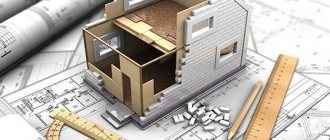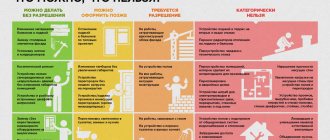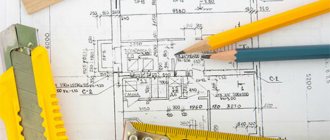Over time, some residents become bored not only with the interior of their apartment, but also with the layout, and then they decide to radically change everything, and without permission. In the future, you will need a statement of claim to preserve the redevelopment of the apartment.
Rooms are being united, walls and storage rooms are being torn down, and the laying of communications is being adjusted. In this case, the question inevitably arises: how to legalize the redevelopment of an apartment?
This can be done both administratively and through the courts. The decision depends on the specific circumstances. In the latter case, it is necessary to file a claim with the court to legalize the redevelopment of the apartment. We will definitely dwell on the features of its preparation in this material.
Legalization of unauthorized redevelopment in an apartment
So, if you set out to find out whether it is possible to legalize redevelopment in an apartment, then you should know the procedure and procedure. Below we will tell you what to do if the redevelopment has already been done without permission.
The first step in order to legalize the redevelopment of an apartment is to collect the necessary documents.
These will include technical and design documentation for the apartment, approvals from government services, neighbors, other owners and the management company. In addition, you will need to contact local authorities responsible for architecture.
Here's what needs to be done in order to legalize the redevelopment with the help of the court.
Do not forget that the final decision will be made by the court after considering your claim to preserve the apartment in a redesigned state.
After satisfying it, you will also have to perform a number of necessary actions. We will also mention them further in the text.
As practice shows, legalizing AWOL is quite a troublesome matter. Therefore, it would be useful to resort to the services of a lawyer who has thoroughly mastered the real estate niche.
A housing lawyer will not only help prepare all the documents, but will also provide services to support the legal process of legalizing unauthorized redevelopment of an apartment.
Note! Not every unauthorized redevelopment can be legalized, therefore, before breaking down walls, combining a room with a balcony and loggia, or moving a kitchen and bathroom, consult a lawyer.
The result of consideration of the claim for redevelopment of the apartment
The court will decide to preserve the apartment in its redesigned form only if the plaintiff provides evidence of the safety of the structures and the apartment as a whole. Redevelopment must not violate the rights of third parties. If there are several apartment owners, they will all be involved in the case. After the court decision comes into force (taking into account the appeal), the owner must contact the BTI. To make changes to the documentation for the apartment.
In cases where it is impossible to legalize the redevelopment, the court will also make a decision. He may impose an obligation on the person who has unauthorizedly redesigned the apartment to restore the housing to its original condition. If the decision is not implemented, such an apartment may be sold through an auction. For the tenant, such a decision entails early termination of the rental agreement without the provision of other housing. Therefore, before going to court with a claim for redevelopment of an apartment, pay attention to the collection of evidence.
If the apartment has a mortgage, is it possible to legalize
How to legalize unauthorized redevelopment if the apartment is under mortgage?
Many people nowadays buy homes with a mortgage. In this case, there may also be a need to legitimize the redevelopment.
In this case, you should definitely pay attention to the fact that the bank’s consent is required to change the redevelopment of the mortgaged apartment.
It may also contain certain conditions imposed on the home owner. They may, among other things, involve providing the bank with new documents after completion of the entire process.
There are situations when an apartment you like has unauthorized redevelopment. The owner assures that there will be no problems.
He prepares documents for the bank, and at the same time significantly reduces the price, supposedly for expenses for legalizing unauthorized redevelopment; try to avoid such transactions, because all responsibility falls on you.
Obtaining such a written document may require approval from the insurance company if the home is insured.
It is possible that the bank will need a copy of the expert’s opinion to the effect that the unauthorized redevelopment complies with all building codes and requirements.
Practice shows that if the redevelopment of an apartment is included in the building codes, then most often the banks for their part do not create obstacles.
When judicially legitimizing redevelopment in the case of a mortgage, the bank should be involved in the case as a third party.
Documents required for court
If it is necessary to legalize redevelopment in Moscow in court, then in addition to the statement of claim, you need to collect the following documents to preserve the apartment in its new form:
- Documents confirming ownership.
- Conclusion of the design organization (with access to SRO) regarding the compliance of changes made in the apartment with building regulations.
- Conclusions of gas workers, firefighters, as well as specialists from the SEZ.
- Technical passport of a residential premises with plans before and after redevelopment.
- Consents from other owners, neighbors, management company.
- Consent of the bank (in a situation with a mortgage).
- Acts for hidden work (if load-bearing structures were affected during the repair).
In addition, in order for unauthorized redevelopment to be legalized in court, it is necessary to pay a state fee for consideration of the claim. Its size is 300 rubles.
It is worth remembering that each redevelopment case is individual. Therefore, it is advisable to clarify the final package of documents required for the court with a lawyer in advance.
We are preparing a statement of claim to preserve the apartment in its redesigned state
After all the documents are in the hands of the specialist, he will write a claim for redevelopment of the apartment. It will contain information about the residential premises and all the work that was carried out in it.
The defendants in the lawsuit are the local government authority, whose competence includes the approval of projects.
In the statement of claim, you need to write for what reasons it was not possible to legalize the redevelopment administratively. In this case, you need to refer to all available permits and approvals from supervisory authorities.
In conclusion, you should ask the court to preserve the apartment at a specific address in a rebuilt state according to the registration certificate as of the date the unauthorized refurbishment was discovered by the BTI technician.
If you are preparing documents for the court, then you can take as a basis a statement of claim to preserve the redevelopment of the apartment, a sample of which we offer to download on our website. You can change it to suit your own specific situation.
When a claim to legitimize the redevelopment of a residential premises, namely your apartment, has been prepared independently, it is advisable to familiarize a lawyer with its draft.
He will point out in advance all the legal shortcomings of the document and help eliminate them. In addition, it is possible that additional arguments may appear.
A sample claim for legalization of apartment redevelopment posted on our website contains all the necessary information. It will be useful both to the common man and to the novice lawyer.
What not to do and why
Load-bearing partitions do not tolerate interference
Load-bearing structures with ventilation ducts must not be touched—neither demolished nor moved. It is possible to cut new doorways into them or expand existing ones only with reinforcement. You can’t even dig potholes for pipes and electrical communications. These structures must be approached with extreme caution; do not take risks - consult experienced builders and architects. The slightest mistake with a load-bearing wall and the house could collapse.
The limits of what is permitted during redevelopment vary depending on the design, series and material of the house, as well as regulatory documents, the severity of which varies in each region of the country.
Prohibitions related to kitchen and lighting
Partitions between living quarters and a kitchen with a gas stove/water heater are prohibited from being dismantled. If you replace them with a sliding door, there will be a chance to coordinate such a modification, but this concession only applies to apartments with two or more rooms. It is also prohibited to install kitchens above residential premises, but above commercial real estate (offices, cafes, shops) - it is possible. Kitchens and other rooms must a priori have a source of natural light - no one will allow you to design and approve a new room without windows.
Bathroom transformations
Bathrooms, toilets and showers cannot be placed above the living room, kitchen or instead of these rooms. It is also forbidden to make entrances to the bathrooms from these rooms. Doors to them can only lead from corridors. With any modifications to the bathroom, there must remain free access to the general house water and heat supply communications. If, when modeling the interior of a bathtub or toilet, you decide to hide unsightly pipes and taps with a decorative box, it should have a door or a removable element so that in case of force majeure the master can get to the communications.
You also need to warm up according to the rules: warm floors, radiators and fireplaces
Only an electric heated floor system is allowed; a water version cannot be installed, as this would be unauthorized use of the building’s water and heat pipes. Solid fuel fireplaces in an apartment are forbidden fruit; only bio-, electric- and decorative versions are allowed, and even then the room must have a powerful hood. It is impossible to move radiators to a loggia or balcony, which are combined with living spaces; such actions distort the building’s heat supply system. Due to such a warm redevelopment, neighbors from adjacent apartments may experience a temperature drop of several degrees during the winter.
Registering changes
The process of legalizing unauthorized redevelopment does not end with a court decision. After this, technical and cadastral passports should be reissued taking into account the changed condition of the apartment.
When illegal redevelopment resulted in changes in the size of housing, then the corresponding information should be entered into the registration data for the property.
To do this, an application with a copy of the new technical passport is submitted to the local branch of Rosreestr.
Here is the basic thing you need to know about how to legalize unauthorized redevelopment. Let us emphasize once again that the help of a lawyer in this matter will greatly facilitate the task.
Decor
How to do it? We will describe the actions that need to be taken in the form of step-by-step instructions.
There is a prescribed application form for the reconstruction of residential premises.
The applicant enters the required information in the blank columns of the printed form.
The document is sealed with the applicant’s handwritten signature and, in some cases, certified by the operator who accepted it.
Sample application for redevelopment of an apartment.
Application for redevelopment of an apartment according to the established form 266.
You can learn about whether it is necessary to legalize changes in the layout that have already been made, as well as how to buy or sell a home with a redesigned layout from our articles.
An example of a statement of claim for the preservation of unauthorized redevelopment in an apartment
Many owners want to change the appearance of their apartment. Some people like to combine the living room with the kitchen, both bedrooms, or make a shared bathroom. All these actions are included in the concept of “redevelopment and reconstruction of residential premises.”
However, in a number of cases, completed transformations cannot be legalized administratively. The changes were discovered after purchasing the apartment under a sales contract or as part of an inheritance. In such a situation, a number of owners are unsuccessfully trying to obtain the necessary documents through the corridors of officials.
However, the problem can be resolved through the courts. To do this, a claim is filed. Its subject is to preserve the apartment in a redesigned state. Below is an example of a claim.
Cheryomushkinsky District Court of the South-Western Administrative District of Moscow
Moscow, st. Krzhizhanovskogo, 20/30, bldg. 3
Plaintiff: Popova Anastasia Dmitrievna
Moscow, Domashny lane 3, apt. 4
Respondent: Department of Communal Property
Moscow city administration
Moscow, st. Extreme, 324
Statement of claim
about preserving the apartment in a state of redevelopment
I, Popova Anastasia Dmitrievna, live in apartment No. 4 at Domashny Lane 3. This residential premises belongs to me by right of ownership under a purchase and sale agreement concluded with Sergei Ivanovich Viktorov on June 16, 2020. My rights to the apartment are confirmed by an extract from the unified register of real estate under No. 147234.
Now I want to sell my home due to the need to move to another city. However, the following problems arose.
In the copy of the technical passport received at the conclusion of the initial transaction, I discovered some inconsistencies with the current contours of the apartment.
The bathroom is combined, although according to the documents it is designed as separate. In addition, the area of the balcony in the living room was increased by removing the partition in the living room.
It was not possible to legalize the redevelopment administratively due to the fact that the first owner of the apartment did not provide the necessary documents confirming the construction work.
The redevelopment carried out by the previous owners does not violate current building codes and does not threaten the life and health of others.
This is confirmed by a certificate from the Municipal Unitary Enterprise BTI dated November 15, 2018.
The territorial body of the State Fire Safety Inspectorate, in its conclusion dated November 30, 2018, indicated that the work done by the previous owners does not affect the state of fire safety. A positive conclusion was also received from the Federal Budgetary Institution of Health “Center for Hygiene and Epidemiology in Moscow” and the expert organization Tokmos LLC.
Based on the norms of current legislation, namely Art. 29 Housing Code of the Russian Federation, Art. 131, 132 of the Civil Procedure Code,
I ask the court:
Save the apartment located in Moscow at Domashny Lane 3, apt. 4, in a redesigned form in accordance with the technical data sheet as of November 18, 2018.
Application:
1) Receipt for payment of state duty (original - 1 copy).
2) Technical passport of the residential premises (apartment).
3) Technical conclusion No. 12/07 Tokmas LLC.
4) Expert opinion of the Federal Budgetary Institution of Health “Center for Hygiene and Epidemiology”.
5) Certificate from MUP BTI.
6) Extract from the Unified Real Estate Register.
7) Copies of conclusions from municipal services.
Plaintiff Popova A.D.
Statement of claim for apartment redevelopment – court refusal
Redevelopment and redevelopment of residential premises can only be legalized in court. But the court does not always make a decision in favor of the applicant. It is impossible to legalize redevelopment if:
- the ventilation of the house is impaired
- the area of the gasified kitchen has been increased
- gas pipes moved
- The bathroom has been enlarged due to the living space
- plumbing ducts dismantled
- heating appliances have been moved to the balcony or loggia
- new “wet places” have appeared (relocation of the kitchen, toilet and, respectively, removal of utility networks), etc.
That is why, before going to court, it is important to collect the findings of the authorities and use them as evidence. A technical report on the compliance of the work performed with building codes and regulations, a report on the compliance of the redevelopment with sanitary and epidemiological requirements, fire safety, and, if necessary, on compliance with the requirements of SNiP systems of internal water supply and sewerage networks, etc.








